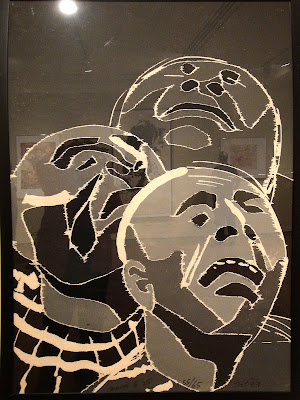Yue Minjun -Woodcut 1 The Grasslands Series - woodcut 47 x 34" - 2008
Smith College Museum of Art is currently hosting an exhibition titled, Collecting - Art of Asia. While I found fascinating work throughout the exhibit, I spent most of my time in the Sacerdote Gallery on the main floor with Prints: 1950 - 2013. The artists, representing Japan, China, Korea and Pakistan use a variety of printmaking techniques. Of special interest to me as a printmaker was a chance to see some practitioners of sosaku-hanga. Sosaku-hanga, which literally means "creative prints" is a 20th century departure from the traditional division of the labor of producing a woodblock print with the artist taking control of all three of the main tasks of producing a woodcut print. In the ukiyo-e genre that most of us are familiar with you actually have a collaborative process involving an artist, a carver and a printer. In sosaku-hanga the artist works all three disciplines.
Munakata Shikō Sand Nest 1938 (printed in 1957) 13.5 x16 woodcut
Munakata's small block printed simply in black is a wonderful example by one of the artists associated with sosaku-hanga. Munakata was known for often spontaneously creating his image during the carving process. As a printmaker who plans the image but is open to change inspired by the carving process the idea of just beginning a a carving to see what emerges is both frightening and intriguing.
Another favorite from the show was a print by Kiyoshi Saito. It's hard to describe the difference from seeing this in person to here in thumbnail, but the detail, textures and subtle coloration have an impact that brought me back time and time again to marvel at its creation.
Kiyoshi Saito - Winter in Aizu - woodcut - ca1940
Another post Mao approach to woodcut inspired by western abstraction was a piece by Goto Hidehiko.
Goto Hidehiko Silent Night - woodcut
Silent Night is from a a suite of works commissioned by collectors Mary and Norman Tolman who hoped the collection containing eight artists working abstractly on the subject of "Hope for the Future" would help restore Japan in the aftermath of the 2011 disasters (both political and natural). Goto's piece with its small white space which seems to reach through various surfaces is both a subtle and yet powerful example of the woodcut process.
Fang Lijun 2000.6.25 woodcut 2000 47 x 32"
Another twist to sosaku-hanga was the development of what is termed Cynical Realism. The works typically tend to the ironic or display contempt and disillusionment with Chinese society. Fang Lijun uses jigsaws and power tools to fashion these large and rough figures.
Yue Minjun -Woodcut 2(?) The Grasslands Series - woodcut 47 x 34" - 2008
The piece on top and this are part of the Grassland series by Minjun who is also associated with Cynical Realism. Quoting Minjun, "Smiling is a refusal to think deeply when you feel there are things about which you have no way of thinking deeply or which are too difficult to think about and you need to get rid of your thoughts."
Annie Bissett, woodcut artist and blogger also has a great review of this show.
Smith College Museum of Art - Collecting - Art of Asia - though May 26th (North Hampton, MA)







6 comments:
Love the piece by Goto Hidehiko.. thanks for your blog..
A photo doesn't do it justice. Very subtle gradations of color. Just a gem of a print.
Great piece, Bill. Do you know if Minjun cut the block himself?
I believe so Philip, the printmakers here were described in the catalogue as working Sosaku-hanga or doing the image, cutting and printing.
I find the last image if the smiling man in the grassland incredibly haunting. Enjoyed reading about your visit.
interesting blog and piece
Post a Comment